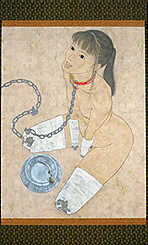
|
|
Dec. 3, 1996
|
Art Watch Index - Nov. 26, 1996
![]()
<<NO FUTURE>>

Makoto AIDA "Dog"1989
MIZUMA ART GALLERY http://ux01.so-net.or.jp/ ~mag/index-e.html
|
<<NO FUTURE>> by Makoto AIDA
The "present" of an artist reflected in his unshown works Among the many young artists of today, the activities by Makoto AIDA are exceptional. Although this particular exhibition is not one introducing his new works, the works involved are fully sophisticated to be considered as part of his current activities. Today, most artists pass through various phases, where early on, they are at a stage of search during their student days, continuing to develop their styles with each exhibition they hold. However, AIDA has already established his style at this point, and he only started his activities after arriving at his "destination". As seen in his works, AIDA is sometimes considered as an eccentric painter (with bad taste?) since he paints pictures of little girls with amputated limbs. However, his is a style which is a random simulation having common elements with various categories of works, such as the Japanese paintings of the early Meiji era, the abstract-expressionistic paintings, paintings of war, and even posters about drawing and manual arts education. Therefore, we must not overlook the fact that the essence of his paintings, as he himself states, is the presentation of "various designs" (Hideo KOBAYASHI) in the painting. The ironical and formalistic emergence of self-consciousness The will for formalism commonly seen in AIDA's works is closer to the "romantic irony" of Yojyuro YASUDA, than to that of KOBAYASHI's. As it is known, Yasuda is the "greatest (worst?) pre-war" critic who expressed in his written works, the state of the Japanese having a restricted modern awareness, by depicting the intention for destruction in the form of an extreme state of contradiction. It may be partly true that his writing incited many young men to volunteer to fight in the wars, but frankly speaking, that is an overestimation of the social role literature has. Insofar as YASUDA's writing style is derived from an esoteric "dark area", such common beliefs are too simplistic. Aida's paintings also have similar "dark areas". When looking at his works, because his skill is so outstanding, we can discern the confrontation between his chaos and clumsiness due to an extreme condition of high skill, with an ironical and formalistic self-consciousness. This strange self-awareness seems to derive from a "romantic irony" towards a Japanese painter of the modern age torn between technique and emotion. In that sense, AIDA's works carry a dull glow as that of a knife pointed at simply "superior" works created by naive "artists" who had thought that paintings and sculpture of the "Western level" could be created, on the foundation of a baseless illusion guaranteed by merely the name, "contemporary art". [Noi SAWARAGI/Art Critic]
|
|
|
|
|
|
|
|
|
Dec. 3, 1996
|
[home]/[Art Information]/[Column]
Copyright (c) Dai Nippon Printing Co., Ltd. 1996
Network Museum & Magazine Project / nmp@nt.cio.dnp.co.jp